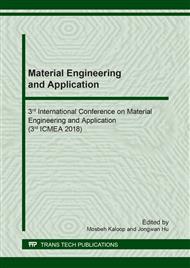p.37
p.45
p.51
p.59
p.64
p.69
p.76
p.82
p.87
Effect of DE-GMAW (Double Electroda Gas Metal Arc Welding)’s Resistance on Mechanical and Physical Properties of Aluminium Alloy Weld
Abstract:
This paper presented the effect of DE-GMAW (Double electrode gas metal arc welding)resistance on mechanical and physical properties of aluminium alloywelded. DE-GMAWis amethodof welding process that use two electrode. A non consumable torch is added to bypass the current inorder to reduce the heat input. The variation resistance used were 15Ω, 30Ω and 45Ω. Universaltesting machine and Vickers microhardness were used to measured mechanical properties of weldmetals with respect to strength and hardness. The microstructure was investigated by microscopeoptic with 100 x magnification. The grain size of weld metals with resistance value 30Ω is finer than15Ω and 45Ω. Dye penetrant test shows DE-GMAW welding machine that made have goodperformance because it can produce welding joint without surface crack. The results show thatresistance values optimum to DE-GMAW welding on aluminium alloy 5051 with 4 mm thickness is30Ω. It can be seen from the tensile test that shows the highest tensile strength is found in the DEGMAWwelding with resistance values 30Ω.
Info:
Periodical:
Pages:
64-68
Citation:
Online since:
November 2018
Keywords:
Price:
Сopyright:
© 2018 Trans Tech Publications Ltd. All Rights Reserved
Share:
Citation:


